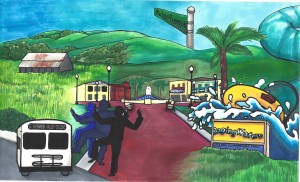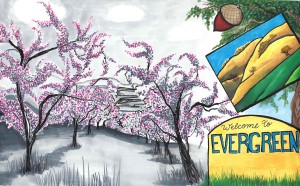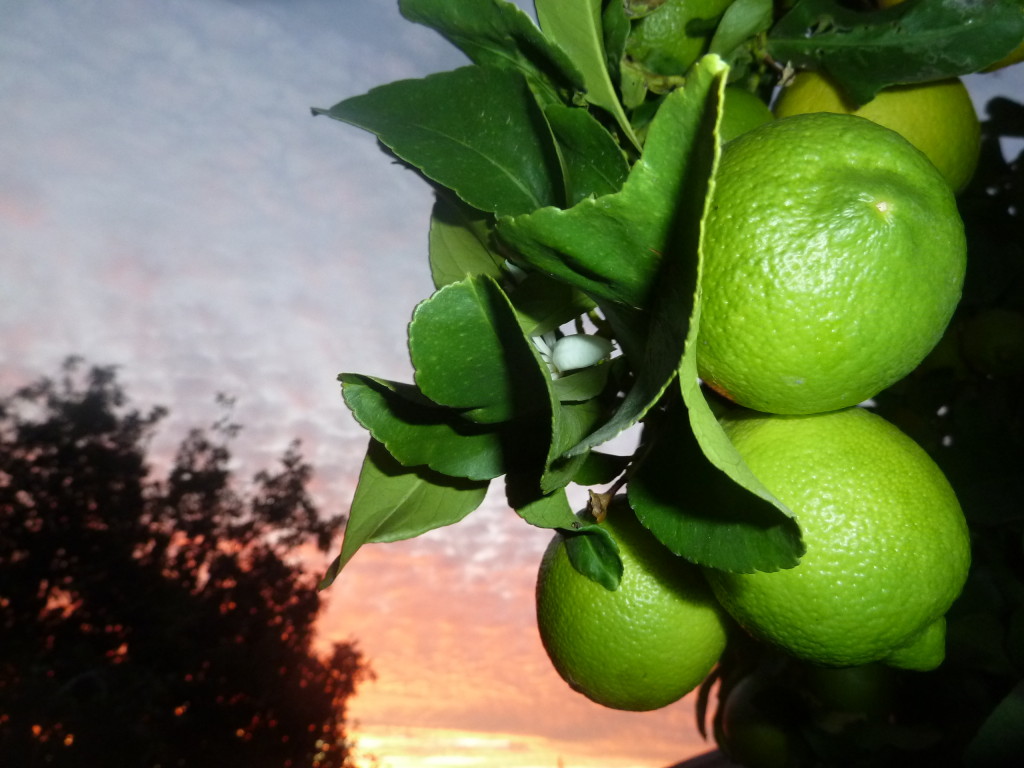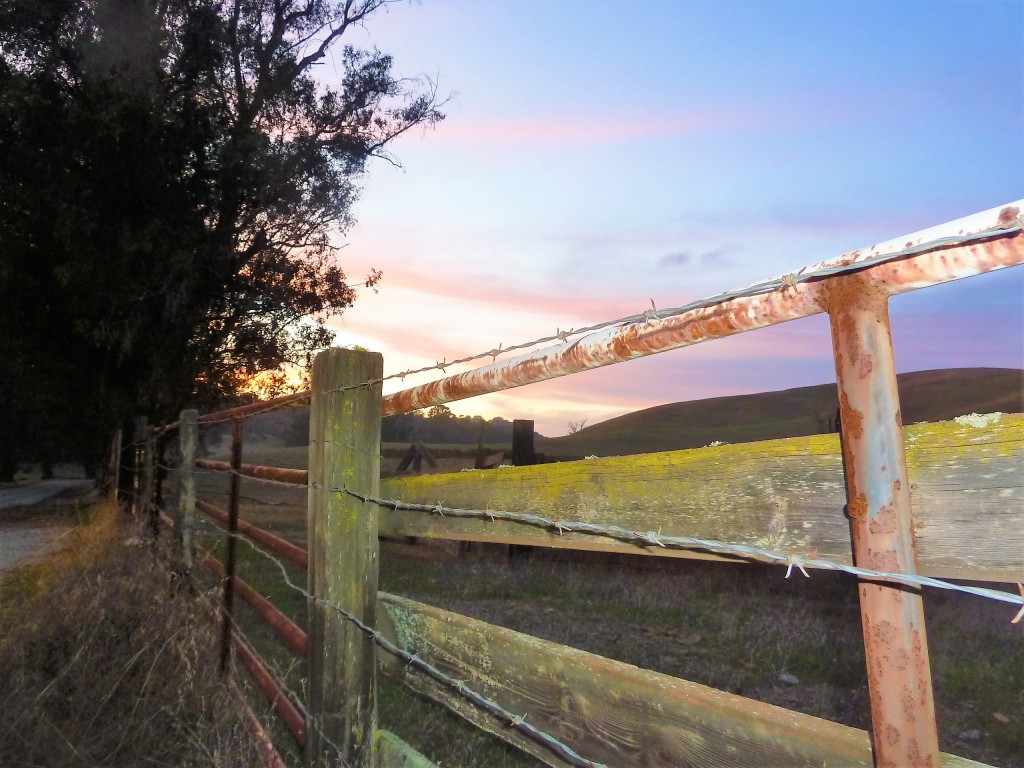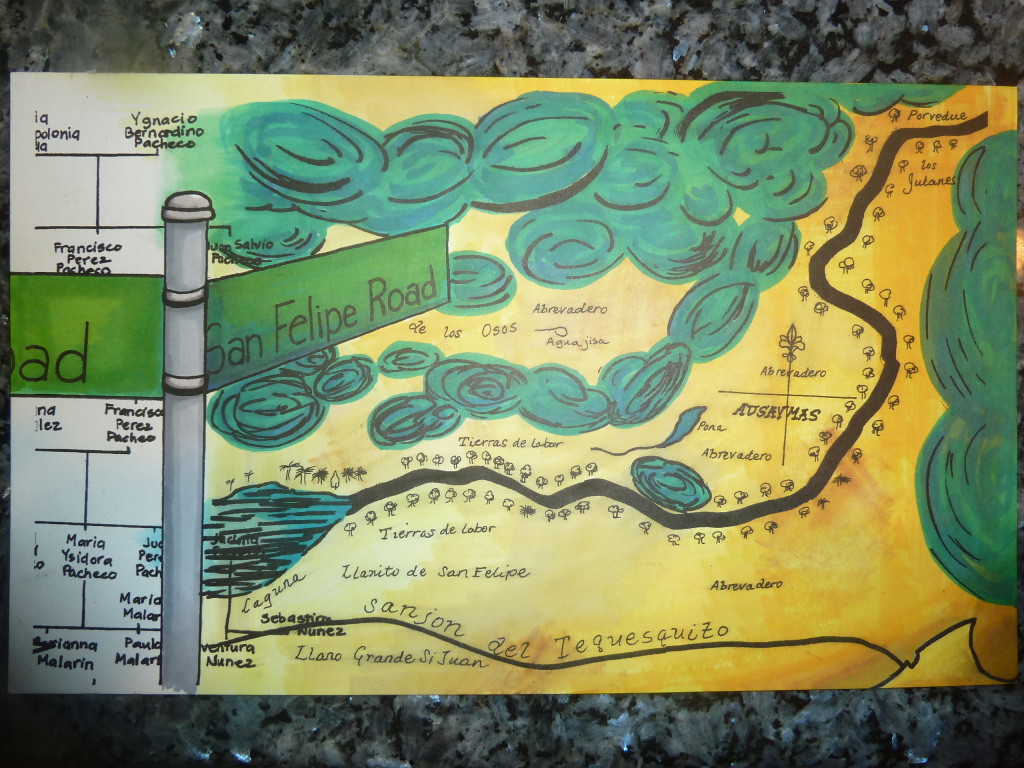These awesome panels had to make way for more informational or more meaningful pieces. All of the artwork is based on research, so picking the important parts was difficult. Some clips stayed, but this is essentially the drawing room floor.
Category Archives: Artwork

Evergreen Sunsets
I have to tell you, one of the most charming things about Evergreen is the consistent, stunning sunsets.
Due to coastal breezes bringing wispy clouds from the Pacific and a haze of pollution exactly west over the highways, Evergreen marvels in pink and purple clouds nearly daily. Our hills let us climb up and see the sun set over the Silicon Valley landscape. Here are some of my favorites from my research photos. I would take a drive through our gorgeous hills when experiencing writer’s block throughout the creative process. Inspiration and Evergreen beauty would find me on these refueling drives.

Research and Design
 I thought I may take a moment to talk about how this project came together. All of these pieces connect to a side and time of Evergreen. I’ve had to strip out the creative portions because I had no idea how rich this history was. It doesn’t need any fluff.
I thought I may take a moment to talk about how this project came together. All of these pieces connect to a side and time of Evergreen. I’ve had to strip out the creative portions because I had no idea how rich this history was. It doesn’t need any fluff.
Luckily, I’m from Evergreen, so large portions of this is based on experience. I knew approximately what things were there or important. Like most works today, I started with a Google search. This led to lots of reading of books online and combing through photos. Lots of notes on groundbreaking lawsuits in Evergreen. It helps explain the acceleration of newcomers in the 1860’s. Oh boy. That’s a totally different blog for another time.
 I read all of Colleen Cortese’s “Evergreen Pathways” articles published in the Evergreen Times. This experience and googling was really the starting place for my artwork. History San Jose also has a large collection of old photos.
I read all of Colleen Cortese’s “Evergreen Pathways” articles published in the Evergreen Times. This experience and googling was really the starting place for my artwork. History San Jose also has a large collection of old photos.
This led me to many libraries across the Bay Area. Can I see this document in person? Can I get a better resolution picture? Is there background information to what I’m seeing here?
I have been coordinating with UC Berkley’s Bancroft Library, SJSU’s California Room and Sourisseau Academy’s Archives, Evergreen Valley College’s Heritage Room and other local resources. They have a lot online, but I suggest going in person. There’s nothing like the smell of old maps.
 If you’re looking for newspaper clippings or old resident references specifically, head to the California Room and bring quarters. Set an alarm on your phone to the meter. You don’t want that parking ticket. If you’re looking for amazing old photography, head to Sourisseau Academy next door. Evergreen history, head to the Heritage Room curated by Colleen Cortese. The Italian American Heritage Foundation also had an amazing photo array and library. Everyone has been so gracious with my repeated visits. If you were looking for old relatives, I might do a catalog search at the California Room at the Martin Luther King Library. You might find something cool.
If you’re looking for newspaper clippings or old resident references specifically, head to the California Room and bring quarters. Set an alarm on your phone to the meter. You don’t want that parking ticket. If you’re looking for amazing old photography, head to Sourisseau Academy next door. Evergreen history, head to the Heritage Room curated by Colleen Cortese. The Italian American Heritage Foundation also had an amazing photo array and library. Everyone has been so gracious with my repeated visits. If you were looking for old relatives, I might do a catalog search at the California Room at the Martin Luther King Library. You might find something cool.
 So, finding the original documents to work from wasn’t going to be a problem, as long as I had sentiment to connect them to. This helps substantially in setting the tone and color of the artwork itself.
So, finding the original documents to work from wasn’t going to be a problem, as long as I had sentiment to connect them to. This helps substantially in setting the tone and color of the artwork itself.
In order to do that, I had to go collect that feeling. That led me to new people. I sat down face to face with a ton of amazing people, some who are represented within the artwork and those who aren’t. This also allowed the artwork to be tide to people and industries that bring a well rounded story together.
 I sat down with educators, ranchers, farmers, vintners, orchardists, veterans, businessmen, authors and politicians. Specifically, I sought out Pioneer Evergreen families. We generally discussed growing up Evergreen or in Evergreen. The overwhelming feeling is that the land provided them with food, wine, friendship, inspiration and joy. They brought continued inspiration through the design process. Through contributing photos and stories, it brought further meaning to the artwork. I think it’ll inspire the audience. What inspired me was the warm, salt of the Earth nature everyone has.
I sat down with educators, ranchers, farmers, vintners, orchardists, veterans, businessmen, authors and politicians. Specifically, I sought out Pioneer Evergreen families. We generally discussed growing up Evergreen or in Evergreen. The overwhelming feeling is that the land provided them with food, wine, friendship, inspiration and joy. They brought continued inspiration through the design process. Through contributing photos and stories, it brought further meaning to the artwork. I think it’ll inspire the audience. What inspired me was the warm, salt of the Earth nature everyone has.
 But people can only tell you so much about what came before. Descendants of Pioneers and old time residents could tell you about their parents’ and grandparents’ versions of Evergreen, but what about before the Spanish colonized the area? Where do we confirm materials and accuracy for our Ohlone Tamien Muwekma Native Americans? I headed back to the experts at the SJSU Anthropology Department for some inspiration. I might also reach out to Native Muwekma organizations for an interview.
But people can only tell you so much about what came before. Descendants of Pioneers and old time residents could tell you about their parents’ and grandparents’ versions of Evergreen, but what about before the Spanish colonized the area? Where do we confirm materials and accuracy for our Ohlone Tamien Muwekma Native Americans? I headed back to the experts at the SJSU Anthropology Department for some inspiration. I might also reach out to Native Muwekma organizations for an interview.
 In addition to connecting with the proper resources and people, I found myself taking long drives and snaking through the Evergreen hills. I was forming a connection to the land and roads. It fuels my engine. There’s nothing like watching a sunset in Evergreen go down. This definitely adds to the artwork, even if it’s just added justification for how beautiful Evergreen really is. This kept me going through the creative process, but also adds further experience to some of the untouched hillsides needed throughout the collection.
In addition to connecting with the proper resources and people, I found myself taking long drives and snaking through the Evergreen hills. I was forming a connection to the land and roads. It fuels my engine. There’s nothing like watching a sunset in Evergreen go down. This definitely adds to the artwork, even if it’s just added justification for how beautiful Evergreen really is. This kept me going through the creative process, but also adds further experience to some of the untouched hillsides needed throughout the collection.
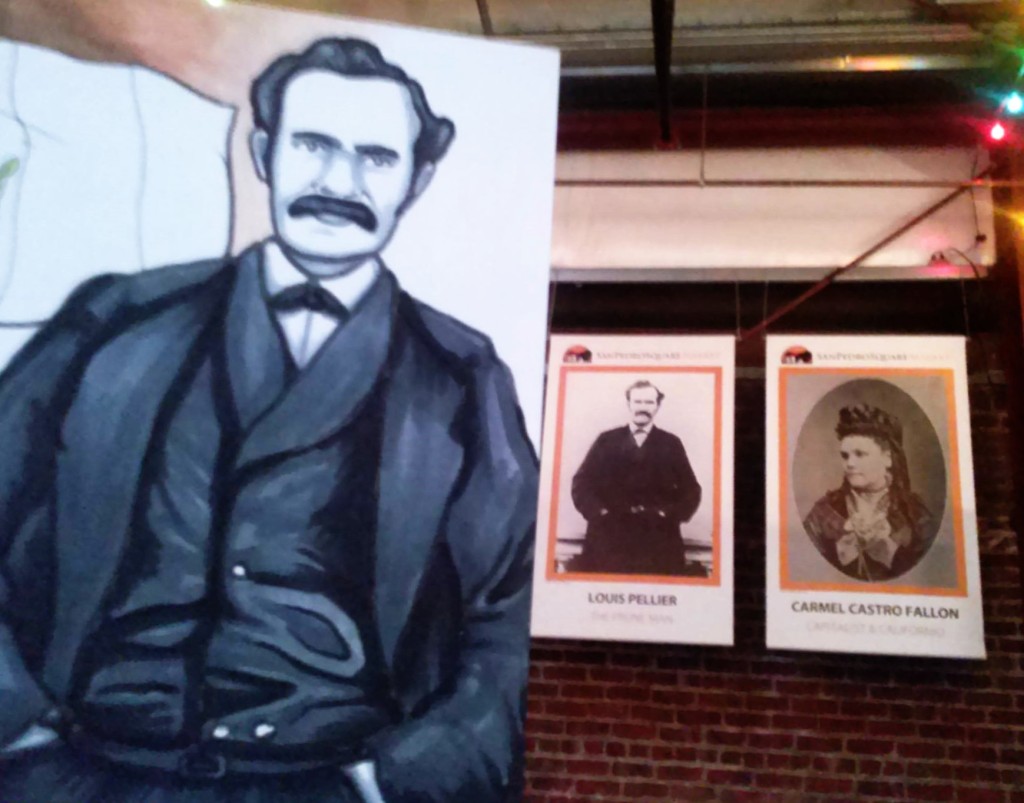 I am making my last finishing touches to the artwork, but because it comes from decisive places, it’s easy to write about later. The blog will use all the research and interviews to tell the story along with artwork. Evergreen gets to be my Muse and it’s been a wonderful experience getting in touch with where I’m from.
I am making my last finishing touches to the artwork, but because it comes from decisive places, it’s easy to write about later. The blog will use all the research and interviews to tell the story along with artwork. Evergreen gets to be my Muse and it’s been a wonderful experience getting in touch with where I’m from.

Flying through Evergreen
 Evergreen in the southeast corner of San Jose has a long legacy of ranching, agriculture and entrepreneurship throughout its timeline, creating continuity and inspiration throughout this collection of murals that I have planned for our Evergreen Gateway. Another legacy Evergreen has had over time is a love affair with flight and the sky.
Evergreen in the southeast corner of San Jose has a long legacy of ranching, agriculture and entrepreneurship throughout its timeline, creating continuity and inspiration throughout this collection of murals that I have planned for our Evergreen Gateway. Another legacy Evergreen has had over time is a love affair with flight and the sky.

In 1876, one of California’s wealthiest citizens, James Lick, put aside the funds for the most powerful telescope ever and world’s first mountain top observatory. It couldn’t be done without the County of Santa Clara building the windy road that same year. James Lick Observatory nearby Evergreen began construction in 1880 and completed in 1888. Located on Mount Hamilton, horses brought materials up a series of switchbacks to reach the summit beyond the paved road, now Highway 130. There is a whole list of discoveries and research coming out of the observatory. But…. this is just outside of Evergreen. People would have stopped in Evergreen on their way to East San Jose, Smith Creek and James Lick Observatory.
 Around the same time the observatory was being built, John Joseph Montgomery(1858-1911) was looking up at birds flying through the sky. The engineer and physicist set out to invent a glider that mimicked their wings. Montgomery would move to Evergreen with his family, and continue his experiments by running off the slope of the hills. His flight experiments would predate that of the Wright Brothers and become the first heavier than air vehicle to take flight. These flying machine designs would be inspired by the coastal gulls and Evergreen indigenous Turkey Vultures, articulating and guiding the air. His inventions would go to the World Fair and make him famous all over the country. Later becoming a professor at Santa Clara University, both he and his assistant, Daniel Malohney, would loose their lives in aviating accidents in the early 1900’s. Their work made the Wright’s Brothers flight possible.
Around the same time the observatory was being built, John Joseph Montgomery(1858-1911) was looking up at birds flying through the sky. The engineer and physicist set out to invent a glider that mimicked their wings. Montgomery would move to Evergreen with his family, and continue his experiments by running off the slope of the hills. His flight experiments would predate that of the Wright Brothers and become the first heavier than air vehicle to take flight. These flying machine designs would be inspired by the coastal gulls and Evergreen indigenous Turkey Vultures, articulating and guiding the air. His inventions would go to the World Fair and make him famous all over the country. Later becoming a professor at Santa Clara University, both he and his assistant, Daniel Malohney, would loose their lives in aviating accidents in the early 1900’s. Their work made the Wright’s Brothers flight possible.
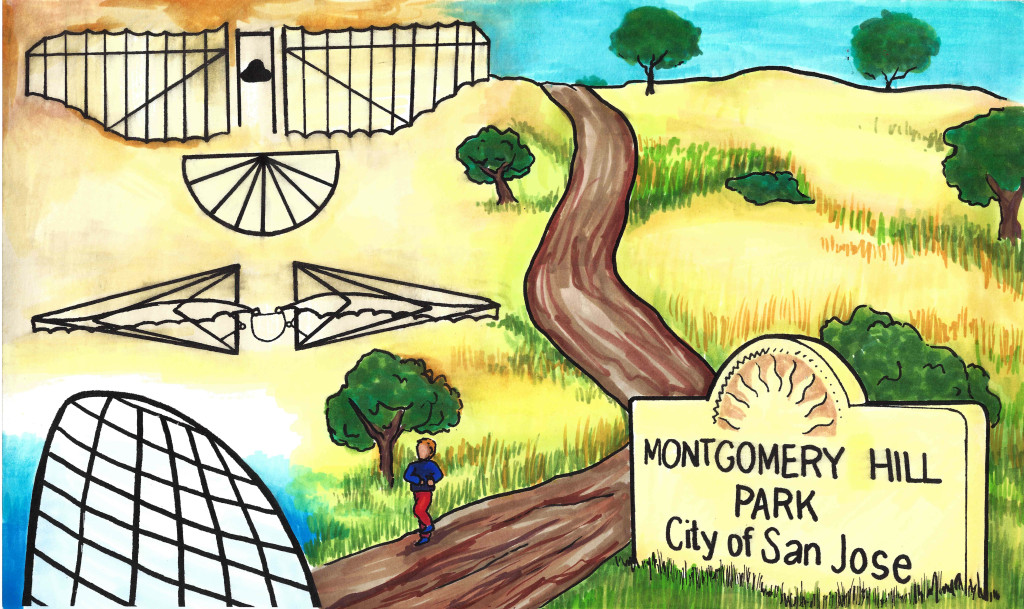 In the Evergreen neighborhood, there are city parks, residential streets, statues and monuments, an elementary school and an observatory at Evergreen Valley College named after inventor, John J. Montgomery. His machines made later innovations within Aviation possible, testing different configurations of wings and mechanism through his work. The Montgomery family were long time residents of Evergreen.
In the Evergreen neighborhood, there are city parks, residential streets, statues and monuments, an elementary school and an observatory at Evergreen Valley College named after inventor, John J. Montgomery. His machines made later innovations within Aviation possible, testing different configurations of wings and mechanism through his work. The Montgomery family were long time residents of Evergreen.
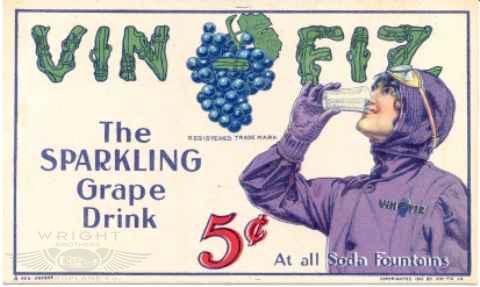 Harriet Quimby(1875-1912) would move to Evergreen in the 1890’s, when Montgomery’s experiments began. Harriet would become a journalist and Hollywood movie screenwriter. She also became a pioneer lady aviator breaking gender barriers and world records. In the midst of Montgomery’s death, she became the first licensed female pilot. Harriet was the spokeswoman for a grape soda company because of her famous purple flight suit. She broke many borders for women in her field and died in an aviating accident in 1912. Unfortunately, Quimby Road is not named after Harriet, but likely one of her distant family members.
Harriet Quimby(1875-1912) would move to Evergreen in the 1890’s, when Montgomery’s experiments began. Harriet would become a journalist and Hollywood movie screenwriter. She also became a pioneer lady aviator breaking gender barriers and world records. In the midst of Montgomery’s death, she became the first licensed female pilot. Harriet was the spokeswoman for a grape soda company because of her famous purple flight suit. She broke many borders for women in her field and died in an aviating accident in 1912. Unfortunately, Quimby Road is not named after Harriet, but likely one of her distant family members.
 Bob and Cecil Reid, World War I veterans, built Garden City Airport in 1935, near present day McLaughlin and 101. Garden City Airport would have to move for the construction of the Highway in 1938.
Bob and Cecil Reid, World War I veterans, built Garden City Airport in 1935, near present day McLaughlin and 101. Garden City Airport would have to move for the construction of the Highway in 1938.
The Garden City Airport would move to Reid Hillview Airport in 1939 northwest of Hillview Golf Club. This NASA research starting at Moffet Field, commercial flights had to go elsewhere. Though the runway wouldn’t be paved until 1946, it was an efficient way to ship fruit out of the Valley of Heart’s Delight. Before that time, fruit had to be shipped by train to the rest of the country and dried fruits were all the rage. Veterans were also enjoying the excitement of flight during peace times.
 The airport expanded in 1965 with the construction of a second runway and the control tower. Over time, the County Fairgrounds and San Jose Speedway would also be located at Evergreen’s Hillview Airport until its expansion. Today, San Jose State University’s Aviation program flies out of Reid Hillview.
The airport expanded in 1965 with the construction of a second runway and the control tower. Over time, the County Fairgrounds and San Jose Speedway would also be located at Evergreen’s Hillview Airport until its expansion. Today, San Jose State University’s Aviation program flies out of Reid Hillview.
 Amelia Reid, Cecil’s daughter-in-law, was another famous woman pilot. The Evergreen flyer earned her commercial pilot’s license and had a fondness for vintage aircrafts herself. Amelia operated a flight school out of Reid Hillview, empowering the next generation of pilots and flight enthusiasts. Amelia’s flight career would last over 60 years.
Amelia Reid, Cecil’s daughter-in-law, was another famous woman pilot. The Evergreen flyer earned her commercial pilot’s license and had a fondness for vintage aircrafts herself. Amelia operated a flight school out of Reid Hillview, empowering the next generation of pilots and flight enthusiasts. Amelia’s flight career would last over 60 years.
Evergreen’s fascination with flight wouldn’t end there. Montgomery Hill Observatory opened at Evergreen Valley College in 2003 and holds star gazing events open to the public today.
Evergreen’s love affair with the flying is still alive and well at Reid Hillview Airport today. Below is the artwork that ties some of this amazing Evergreen history together.

Winnifred Coe Verbica – A Cowgirl paving the way
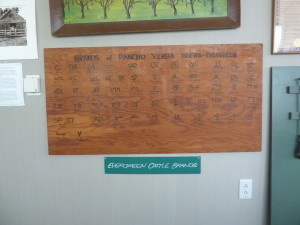 Evergreen is rich with ranching heritage. Generations of ranchers would come out of Evergreen, but there are a couple individuals who have crossed over into the City Slicking lifestyle who have caught my attention. These are individuals who have changed with the times, which must be difficult. I even find it hard at times. I’m addressing that change and that difficulty with this project. We’ll be discussing an inspiring lady with this mural.
Evergreen is rich with ranching heritage. Generations of ranchers would come out of Evergreen, but there are a couple individuals who have crossed over into the City Slicking lifestyle who have caught my attention. These are individuals who have changed with the times, which must be difficult. I even find it hard at times. I’m addressing that change and that difficulty with this project. We’ll be discussing an inspiring lady with this mural.
 Winnifred “Winnie” Hannah Coe Verbica (1935-2013) was the granddaughter of Henry W. Coe, California Pioneer. Before we tell you about Winnie, let’s tell you about where she came from.
Winnifred “Winnie” Hannah Coe Verbica (1935-2013) was the granddaughter of Henry W. Coe, California Pioneer. Before we tell you about Winnie, let’s tell you about where she came from.
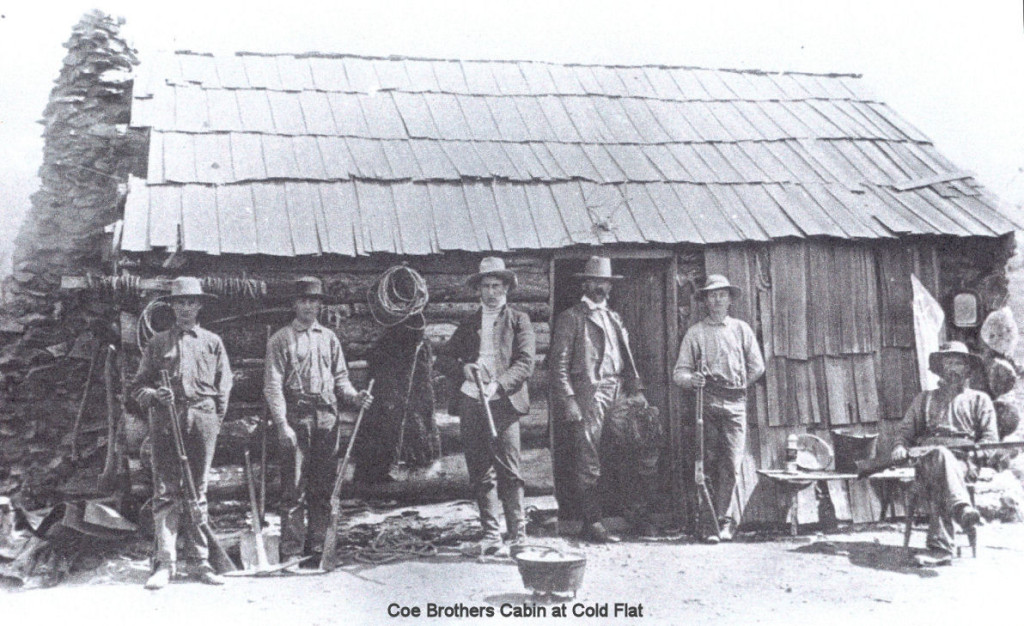 The Coes were descendants of Colonial and Revolutionary Americans. Henry Coe came out West first when he was 16 years old, 1836, making him a pioneer cross the Great Plains. Henry returned to New York to prove himself as a businessman. He was successful but had pitfalls, dusting himself off and starting over. Due to economic stability resulting from a presidential election in the 1840’s, Mr. Coe parted his property to his New York debtors. In 1847, the Coe Brothers, all successful businessmen, decided to go into business together and out West. The brothers stopped in Oregon, but Henry made his way down into California.
The Coes were descendants of Colonial and Revolutionary Americans. Henry Coe came out West first when he was 16 years old, 1836, making him a pioneer cross the Great Plains. Henry returned to New York to prove himself as a businessman. He was successful but had pitfalls, dusting himself off and starting over. Due to economic stability resulting from a presidential election in the 1840’s, Mr. Coe parted his property to his New York debtors. In 1847, the Coe Brothers, all successful businessmen, decided to go into business together and out West. The brothers stopped in Oregon, but Henry made his way down into California.
 Like many pioneers from Evergreen during the 1840’s, the Gold Rush played a major part of their lives before settling in their Evergreen “dream homes”. Luis Pellier took advantage of the lacking fruit industry. Henry Coe would import mining equipment from New York to San Francisco just in time to make it rich. It’s said that Henry knew San Francisco when it had a population of 500. Later, Mr. Coe would return to New York State to marry his high school sweetheart and long lost love, Hannah Smith.
Like many pioneers from Evergreen during the 1840’s, the Gold Rush played a major part of their lives before settling in their Evergreen “dream homes”. Luis Pellier took advantage of the lacking fruit industry. Henry Coe would import mining equipment from New York to San Francisco just in time to make it rich. It’s said that Henry knew San Francisco when it had a population of 500. Later, Mr. Coe would return to New York State to marry his high school sweetheart and long lost love, Hannah Smith.
 The couple returned with their fortune to the quiet countryside of San Jose, California. The Coes were known for their hospitality and kindness. Henry Coe would export hops, tobacco and silks grown in from his Willow Glen 150 acre homestead for 15 years. Henry utilized his New York connections. After poor luck consecutive years farming in the Willows, Henry W. Coe bought large tracts of land from Rancho los Huechos at the Mt. Diablo foothills. Its said his exports were the reason San Jose was designated as “the Garden City”.
The couple returned with their fortune to the quiet countryside of San Jose, California. The Coes were known for their hospitality and kindness. Henry Coe would export hops, tobacco and silks grown in from his Willow Glen 150 acre homestead for 15 years. Henry utilized his New York connections. After poor luck consecutive years farming in the Willows, Henry W. Coe bought large tracts of land from Rancho los Huechos at the Mt. Diablo foothills. Its said his exports were the reason San Jose was designated as “the Garden City”.
 The Coe Family first moved into Evergreen in the 1860’s. The family bought a cattle ranch in San Felipe Valley and Henry would retire there. There, the Coe’s raised cattle, sheep and Arabian Horses. They would hunt on their ranch. The well liked, highly regarded Henry Coe Sr. passed in 1896. Henry Coe’s family would continue to add to their land holdings stretching continuously through Halls Valley and the Mount Diablo Mountain Range to Morgan Hill and present day Henry W. Coe Park. His son Charles and his wife once owned the famed Naglee Mansion. Both sons had a hand in expanding the grazing lands.
The Coe Family first moved into Evergreen in the 1860’s. The family bought a cattle ranch in San Felipe Valley and Henry would retire there. There, the Coe’s raised cattle, sheep and Arabian Horses. They would hunt on their ranch. The well liked, highly regarded Henry Coe Sr. passed in 1896. Henry Coe’s family would continue to add to their land holdings stretching continuously through Halls Valley and the Mount Diablo Mountain Range to Morgan Hill and present day Henry W. Coe Park. His son Charles and his wife once owned the famed Naglee Mansion. Both sons had a hand in expanding the grazing lands.
 Winnie’s aunt and Henry Jr.’s daughter, Sada Sutcliffe Coe, generously donated the land, 12,320 acres, complete with historic buildings, to the State of California. Now, the natural beauty is protected for future generations by the State of California and by some friends of Winnie’s. With 90,000 acres, it’s the second largest state park in California. “She had a sense of pride and gratitude towards her aunt. I never heard an unkind word spoken about her. She [Winnie] supported the decision,” said her son, Peter Verbica. It would be the largest land donation made.
Winnie’s aunt and Henry Jr.’s daughter, Sada Sutcliffe Coe, generously donated the land, 12,320 acres, complete with historic buildings, to the State of California. Now, the natural beauty is protected for future generations by the State of California and by some friends of Winnie’s. With 90,000 acres, it’s the second largest state park in California. “She had a sense of pride and gratitude towards her aunt. I never heard an unkind word spoken about her. She [Winnie] supported the decision,” said her son, Peter Verbica. It would be the largest land donation made.
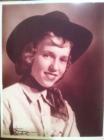 Winnie, daughter of Sada’s brother Henry, grew up in Evergreen, in the San Felipe Valley. She would attend Evergreen Elementary School in the middle of town, then graduated from James Lick High School in 1952. Winnifred was raised around steer and rattlesnakes. Winnie rode through the Evergreen hills and roped cattle. She, like her aunt Sada, wrote beautiful poetry inspired by the wilderness around them in the San Felipe Valley.
Winnie, daughter of Sada’s brother Henry, grew up in Evergreen, in the San Felipe Valley. She would attend Evergreen Elementary School in the middle of town, then graduated from James Lick High School in 1952. Winnifred was raised around steer and rattlesnakes. Winnie rode through the Evergreen hills and roped cattle. She, like her aunt Sada, wrote beautiful poetry inspired by the wilderness around them in the San Felipe Valley.
From the Ranch to the lecture hall, Winnie later attended Stanford University, serving as Treasurer in 1952, making friends with Hewllett and Packard founders, and graduating in 1956. Winnie would become one of two ladies to be accepted to the Stanford Law that year. Winnie Coe would work in Boston for Harvard Professors before marrying Mr. Verbica and coming home to the San Felipe Valley Ranch.
 Winnifred Coe Verbica would write books and poetry from her San Felipe Valley ranch. Winnie had a deep Christian Faith which shines through her writings. Winnifred felt as though the majestic wilderness around her was God’s creativity. I can’t say I haven’t felt that feeling a couple times, that such stunning wicked oak trees speckle those striking hills. It’s easy to be overwhelmed by its natural splendor. Evergreen is a pretty spectacular place.
Winnifred Coe Verbica would write books and poetry from her San Felipe Valley ranch. Winnie had a deep Christian Faith which shines through her writings. Winnifred felt as though the majestic wilderness around her was God’s creativity. I can’t say I haven’t felt that feeling a couple times, that such stunning wicked oak trees speckle those striking hills. It’s easy to be overwhelmed by its natural splendor. Evergreen is a pretty spectacular place.
 Winnifred would eventually leave her Evergreen home, allowing it to be preserved in a Nature Conservancy owned by friends of hers. She moved to Oklahoma to be closer to her daughter and grandchildren in her later years. Her son, Peter, would continue to be inspired by the ranching lifestyle he was raised in, writing poetry and books himself. Peter Coe Verbica received his BA in English from Santa Clara University, a JD from Santa Clara University School of Law, and an MS from the Massachusetts Institute of Technology.
Winnifred would eventually leave her Evergreen home, allowing it to be preserved in a Nature Conservancy owned by friends of hers. She moved to Oklahoma to be closer to her daughter and grandchildren in her later years. Her son, Peter, would continue to be inspired by the ranching lifestyle he was raised in, writing poetry and books himself. Peter Coe Verbica received his BA in English from Santa Clara University, a JD from Santa Clara University School of Law, and an MS from the Massachusetts Institute of Technology.
Descendant of Revolutionary soldiers and Pioneers, Winnifred was an inspirational woman, crossing over and adapting to the changing world around her. Women didn’t commonly go to college during this time and weren’t encouraged to pursue a career. Winnie struggled an accident during law school and still persevered. She was able to wrangle a career along with a family. Winnifred broke barriers for women in the Silicon Valley.
Here’s the artwork I’ve come up with for the Winnifred and the Coe Family Ranch.

Pellier Roots
 The Pellier family and their descendants have been long time Property and Business Owners in San Jose and Evergreen since the late 1840’s. Though one of the murals is designed specifically for the descendants of the Pelliers, I have another mural for what I’m calling the “Pellier Contribution” to San Jose and the Santa Clara Valley.
The Pellier family and their descendants have been long time Property and Business Owners in San Jose and Evergreen since the late 1840’s. Though one of the murals is designed specifically for the descendants of the Pelliers, I have another mural for what I’m calling the “Pellier Contribution” to San Jose and the Santa Clara Valley.
 Mini-History lesson: The Spanish Missions ran the agricultural business and mostly did business with the local naval bases that protected them. The Indians were the farmers and the monks participated as well. However, when California became Mexican Territories, the missions closed down and the Indians were displaced. The vineyards and orchards went dry and much of the valley turned to cattle pasture.
Mini-History lesson: The Spanish Missions ran the agricultural business and mostly did business with the local naval bases that protected them. The Indians were the farmers and the monks participated as well. However, when California became Mexican Territories, the missions closed down and the Indians were displaced. The vineyards and orchards went dry and much of the valley turned to cattle pasture.
 Louis Pellier (1817-72), son of winemakers outside of Bordeaux, had plenty of experience keeping the family farm. At the age of 32, Louis left France during the French Revolution and traveled around Cape Horn to arrive in San Francisco in 1847-8. Louis sent for his brother, Pierre, and they found success gold mining in Weaverville. Pierre served in the French Army during the revolution and came to California in 1849.
Louis Pellier (1817-72), son of winemakers outside of Bordeaux, had plenty of experience keeping the family farm. At the age of 32, Louis left France during the French Revolution and traveled around Cape Horn to arrive in San Francisco in 1847-8. Louis sent for his brother, Pierre, and they found success gold mining in Weaverville. Pierre served in the French Army during the revolution and came to California in 1849.
Louis quickly realized that there were going to be a flood of people coming to California for the Gold Rush and American Dream. The price of the limited produce was extremely high. With family in France and experience he gained on the family farm, Louis could get into that business. Pierre came to California in 1849 in search of gold, but the Pellier brothers returned to their native country several times in search of a different kind of gold.

 On their 1850’s journeys, Pierre brought back his long lost sweetheart, Henriette Renaud. Louis realized his business plans. Louis, Pierre and Jean, the Pellier brothers, stretched out across France, looking for fruit and vegetable varieties to repopulate the rich soil of the Santa Clara Valley. Not all of the plants would arrive alive when traveling by boat. There was a fair amount of learning taking place in the process. In steamer trunks and barrels, the brothers brought seeds, small potted plants and clippings to propagate once back in California.
On their 1850’s journeys, Pierre brought back his long lost sweetheart, Henriette Renaud. Louis realized his business plans. Louis, Pierre and Jean, the Pellier brothers, stretched out across France, looking for fruit and vegetable varieties to repopulate the rich soil of the Santa Clara Valley. Not all of the plants would arrive alive when traveling by boat. There was a fair amount of learning taking place in the process. In steamer trunks and barrels, the brothers brought seeds, small potted plants and clippings to propagate once back in California.
 The brothers improvised when water ran low, presumed to be due to underestimation on the first journey. They kept the clippings alive by inserting them into potatoes for moisture, which worked well.
The brothers improvised when water ran low, presumed to be due to underestimation on the first journey. They kept the clippings alive by inserting them into potatoes for moisture, which worked well.
The Pellier brothers brought some other notable names, the very young Delmas brothers, to California with them. The brothers made considerable amounts of money and bought large plots of land in San Jose and east of San Jose. Unfortunately, the Pelliers sold all their stock of seeds off the dock of Alviso, which meant they had nothing to plant for themselves after the first voyage. This created the necessity of return trips to France, possibly crossing through Panama by train on their way back to California.
 Louis Pellier founded City Gardens Nursery in 1850 with Pierre, at the present day corner of St. James Street and San Pedro Street. The Pellier prune clippings were grafted on to wild Californian prunes, and arranged into rows making the first California prune orchards in 1856. City Gardens was open to the public for picnics and for the nuns to pick freely. The prune was a success, and City Gardens was a cultural hub of Downtown San Jose. The California Prune Industry and Valley of Heart’s Delight radiated outward from the Downtown Pellier orchards. This, however, will be a forgotten garden. The Pellier’s other pride lies east of San Jose in the 1860’s.
Louis Pellier founded City Gardens Nursery in 1850 with Pierre, at the present day corner of St. James Street and San Pedro Street. The Pellier prune clippings were grafted on to wild Californian prunes, and arranged into rows making the first California prune orchards in 1856. City Gardens was open to the public for picnics and for the nuns to pick freely. The prune was a success, and City Gardens was a cultural hub of Downtown San Jose. The California Prune Industry and Valley of Heart’s Delight radiated outward from the Downtown Pellier orchards. This, however, will be a forgotten garden. The Pellier’s other pride lies east of San Jose in the 1860’s.
 Louis and Pierre bought land in Evergreen, which was once part of the Chaboya Land Grant or Rancho Yerba Buena. When Louis sold his portion to Pierre, it became one of the largest ranches in the township of Evergreen.
Louis and Pierre bought land in Evergreen, which was once part of the Chaboya Land Grant or Rancho Yerba Buena. When Louis sold his portion to Pierre, it became one of the largest ranches in the township of Evergreen.
Louis Pellier had a spat with his brothers, presumed to be due to the sale of all the plants or the neglect of their orchards on one of his journeys to France. Pierre took his horticultural skills and expertise to his ranch and vineyards in Evergreen. Louis stayed downtown. Louis took a wife, a woman of French heritage, who wasn’t well suited for him. She quite possibly drove him mad, possibly creating the wedge between brothers.
Don’t worry. There was a lot of love there between the Pellier brothers, even towards the end. Pierre even named his first son after his brother. In 1872, Louis died in a state hospital, due to a nervous breakdown after the separation with his wife. He and his wife had no children. His brother, Pierre, took care of the estate, and the family decided to pay-off the widow with proceeds of the Downtown property. There was a Will in place, but the greedy widow kept coming back for more until a cash settlement was reached.
 Louis’s amazing business venture wouldn’t reach its height for many years. In 1929, California would cultivate 171,330 acres of prune orchards. The La Petite D’Agen from France grafted onto the wild prunes proved to be perfect for California. It was fruitful or meaty enough to be dried, making the prune easy to export all over the country. The growth of the railway system made the export possible. Pierre Pellier brought back the Black Burgundy, French Colombar, Chasselas, Fontainebleau, Pinot Noir, Madeline and others from France. With these new varieties, Louis and Pierre Pellier founded the Valley’s French wine industry at City Garden Nursery.
Louis’s amazing business venture wouldn’t reach its height for many years. In 1929, California would cultivate 171,330 acres of prune orchards. The La Petite D’Agen from France grafted onto the wild prunes proved to be perfect for California. It was fruitful or meaty enough to be dried, making the prune easy to export all over the country. The growth of the railway system made the export possible. Pierre Pellier brought back the Black Burgundy, French Colombar, Chasselas, Fontainebleau, Pinot Noir, Madeline and others from France. With these new varieties, Louis and Pierre Pellier founded the Valley’s French wine industry at City Garden Nursery.
 Pierre Pelliers’s vineyards and orchards a few miles east of San Jose would get passed down to his five children, who later became vineyard owners and winemakers themselves, following in the Pellier’s footsteps, even through Prohibition. The descendants of the Pellier brothers would, in fact, become one of, if not the, most famed business out of Evergreen. The family still has living descendants in family house in the neighborhood. They deserve their own mural in my humble opinion.
Pierre Pelliers’s vineyards and orchards a few miles east of San Jose would get passed down to his five children, who later became vineyard owners and winemakers themselves, following in the Pellier’s footsteps, even through Prohibition. The descendants of the Pellier brothers would, in fact, become one of, if not the, most famed business out of Evergreen. The family still has living descendants in family house in the neighborhood. They deserve their own mural in my humble opinion.
Here’s a look at the artwork I have planned for the “Pellier Contribution.” 
The Evergreen Timeline
I started by daydreaming about the perfect project. Something that did something for everyone and representing something I felt good about. I had a lot of success and discovered my signature at the Falafel Drive In. Could I do that somewhere publicly?
The Evergreen Mural Walk is designed to narrate the story of Evergreen overtime. I’m lived here for 30 years now. When conceptualizing this project, I needed to be able to see that there was a steady story and a wealth of images to communicate my style. Could I do a doodley, stimulating project with Evergreen as the theme? Hmmm…..
Where do we start?
First, I started picking up images and laying them out. But for my brainstorming, I like to work with paper. Something I can visualize and move before considering how to create continuity between them. Anyone who’s received a letter from me knows the paper counts. So, I rolled out the robin’s paper and got taping.
Then, I got drawing. This is what I came up this. It’s bold and colorful, like our people. It’s got black and white and sepia elements to honor our past. A ton of brilliant points in Evergreen History, but do these time periods belong commingled or am I looking at something that needs to be linear? Also, did any of these things deserve emphasis over the other? I don’t think so.
So, using my physical timeline, I researched more totally into the Evergreen area. Turns out, Evergreen was always changing throughout time. It was exciting to note because suddenly, I was conceptualizing a much larger project. Not one mural, but a series of murals.
All of the artwork can lucky come from within the research. It’s amazing! There’s so much here from the Village and community of Evergreen. There will be no artistic caterwauling or psychedelic influences here. It needs so supplementation or filler. If it does need filling, we’re going to use fruit and canning imagery. The Evergreen community has cradled heroic, amazing stories. I can’t wait to paint them for you. The more I discover about my neighborhood, the more inspired I am.
The overall vision is to communicate the ever-changing facade of Evergreen and to show off its strengths while bringing everyone together. With 40 distinct murals, I can convey every 10 years with a redundant rolling hill theme. Creating a little pride and generating a little tourism is going to help Evergreen sparkle.
The way to San Felipe
We’re going way back in time for this one. The 1700’s in fact to discuss San Felipe Road’s origins. Rancho Ausaymas y San Felipe was a large property that encompassed all of Evergreen down to Casa De Fruta and was an extension of Mission San Juan Bautista.
Originally, the land was granted to Francisco Perez Pacheco and that land got passed down through the family. Have you ever gone over Pacheco Pass? In fact, the Pachecos, as landowners, gained wealth and power quickly, buying adjacent ranchos until it spanned from Santa Clara County to Monterey and Merced counties.
 So, when I found this awesome map, provided by the UC Berkeley Bancroft Libraries, I didn’t find it familiar and nothing on the map besides the hills made any sense to me. I didn’t recognize the names of the landmarks. Sanjon? Llanitos? What’s that?
So, when I found this awesome map, provided by the UC Berkeley Bancroft Libraries, I didn’t find it familiar and nothing on the map besides the hills made any sense to me. I didn’t recognize the names of the landmarks. Sanjon? Llanitos? What’s that?
If you can find it on the map, that’s actually the area we’re discussing, Evergreen. Tierras de labor were homes of ranch workers, and would later become the pueblo tract. Those hills in the center of the map following the road are the Evergreen hills and behind the Diablo Mountain range. Ausaymas, also known as Animas, is the Morgan Hill area. Sanjon del Tequesquida is the path to the next Rancho over, to another Pacheco family member.
This giant road through the center of our Evergreen Ranchos is the Arroyo de San Felipe or Road to San Felipe. Wait a second. Sound familiar? Certainly does. With a lake and a larger road nearby? Hm…
So, let’s think on this. 1700’s map making wasn’t perfect. No planes for aerial or overhead shots. Only roads, known geographical features and lengths get noted on a lot of these maps. Directions we not exact. Having said that, I laid out the entire length of San Felipe Road into Gilroy and here’s what I saw.
 This is modern Google day San Felipe Road and the little yellow line is the 101 and where they make a y, 85 splits off at Bernal Rd. I have removed the topography and background.
This is modern Google day San Felipe Road and the little yellow line is the 101 and where they make a y, 85 splits off at Bernal Rd. I have removed the topography and background.
It’s feeling familiar, but is this the same road? The shape is similar. Let’s test it out.
 Here was my first pass overlapping the 2 images without changing anything about the Google version. This wasn’t enough to convince me though. Close, but no cigar. It’s close, but there’s something else here. I started all over again considering what I know about the accuracy of the cartography of the time.
Here was my first pass overlapping the 2 images without changing anything about the Google version. This wasn’t enough to convince me though. Close, but no cigar. It’s close, but there’s something else here. I started all over again considering what I know about the accuracy of the cartography of the time.
So, I rotated, blew it up, then skewed it. Much better. At least this makes sense.
This is the majority of San Felipe road ending around Morgan Hill. Where there’s an obvious tear in the page it approximately where White Road and San Felipe Road split. Now, there’s been a little rerouting (straightening) and paving over the last 250 years. The difference in the 2 overlaps is the scale and direction. What should’ve pointed North on the map actually points East.
Mount Hamilton is featured in the upper left hand corner of our map. The Laguna is Lake Cunningham. The Llanito are little waterways or creeks. Sanjon del Tequesquida is currently the same path as the 101, not yet known as the El Camino Real or Mission Trail. Ausaymas is Animas just above Lake Anderson.
Rancho San Felipe passed down to Maria Ysidora Pacheco, but with Mexican Independence, the Spanish family lost their holdings. The Pachecos were first granted the land in exchange for governing the people. The next family from Mexico to own Rancho San Felipe would do the same thing. Rancho San Felipe would soon become the property of lawmen and cattle herder Antonio Chabolla’s.
Here’s our send up to the Pachecos and Rancho Ausaymas y San Felipe.

The Legacy of Antonio Chaboya
 Antonio Chaboya’s name isn’t really well known throughout San Jose but his land holdings certainly are today. Rancho Yerba Buena, parts at least, stayed in the Chaboya family for over a hundred years. From all accounts, they were exemplary citizens predating the European or American immigrants.
Antonio Chaboya’s name isn’t really well known throughout San Jose but his land holdings certainly are today. Rancho Yerba Buena, parts at least, stayed in the Chaboya family for over a hundred years. From all accounts, they were exemplary citizens predating the European or American immigrants.
 Antonio Chaboya, born in Mexico in 1803, obtained one of the first land patents from the Mexican Government, post-Spanish rule. Antonio and family probably came to the Santa Clara Valley with father, Marcos Chaboya, to colonize the area during the late Spanish Period. With Mexican Independence shortly after, the Spanish Missions were decommissioned and their large land tracts were up for grabs. The Missions once were the source of agriculture for the Spanish. Antonio Chaboya enjoyed one of the largest tracts of land afterwards.
Antonio Chaboya, born in Mexico in 1803, obtained one of the first land patents from the Mexican Government, post-Spanish rule. Antonio and family probably came to the Santa Clara Valley with father, Marcos Chaboya, to colonize the area during the late Spanish Period. With Mexican Independence shortly after, the Spanish Missions were decommissioned and their large land tracts were up for grabs. The Missions once were the source of agriculture for the Spanish. Antonio Chaboya enjoyed one of the largest tracts of land afterwards.
 Rancho Yerba Buena raised a huge herd of cattle, hundreds horses and various crops. Antonio Chaboya and his family enjoyed a fairly untouched version of Evergreen, not being able to cultivate it all. Rancho Yerba Buena’s rolling hills were populated with grasslands, creek beds, spearmint and oak trees. Yerba Buena translates to spearmint in Spanish. Rancho Yerba Buena was over 25,000 acres, making it a high maintenance property.
Rancho Yerba Buena raised a huge herd of cattle, hundreds horses and various crops. Antonio Chaboya and his family enjoyed a fairly untouched version of Evergreen, not being able to cultivate it all. Rancho Yerba Buena’s rolling hills were populated with grasslands, creek beds, spearmint and oak trees. Yerba Buena translates to spearmint in Spanish. Rancho Yerba Buena was over 25,000 acres, making it a high maintenance property.
 Antonio Chaboya was granted the land originally in 1833 by the Mexican Rule, but had to fight to keep it through the 1860’s in the United States. The Chaboyas and their ranch hands even fought and killed bears on their property. The family hosted an annual rodeo at Rancho Yerba Buena for the young horsemen they employ and of the pueblo. The Chaboyas traded a lot of cowhides with Americans and enjoyed a wealthy lifestyle. The property was left to Antonio’s descendants in his passing in 1865.
Antonio Chaboya was granted the land originally in 1833 by the Mexican Rule, but had to fight to keep it through the 1860’s in the United States. The Chaboyas and their ranch hands even fought and killed bears on their property. The family hosted an annual rodeo at Rancho Yerba Buena for the young horsemen they employ and of the pueblo. The Chaboyas traded a lot of cowhides with Americans and enjoyed a wealthy lifestyle. The property was left to Antonio’s descendants in his passing in 1865.
 After the Mexican American War, Antonio Chaboya again was granted Rancho Yerba Buena by the US Government in 1858, one of the first real estate cases heard over “squatters’ rights”.
After the Mexican American War, Antonio Chaboya again was granted Rancho Yerba Buena by the US Government in 1858, one of the first real estate cases heard over “squatters’ rights”.
Antonio’s brother, Pedro Chaboya, served as one of the first lawmen in the area under Mexican Independence. Pedro Chaboya lead the fight when under Spanish rule to defend the ranchos of the Santa Clara Valley from Native Americans and create some peace for the ranchers. He would maintain a much smaller land patent west of Rancho Yerba Buena, near the present day fairgrounds.
 We will discuss Evergreen’s land fights, though we didn’t focus much on it within the artwork itself. Rancho Yerba Buena was over 25,000 acres and hard to scout and watch at all times. As cattle grazed throughout Evergreen, it might have been years until someone came upon a new farm or Native camp popping up. The Chaboyas had to part with Rancho Yerba Buena in sections to provide newcomers the opportunity of the American Dream. With this realization, Downtown Evergreen on San Felipe Road and Aborn Road was the first area densely populated with new farmers.
We will discuss Evergreen’s land fights, though we didn’t focus much on it within the artwork itself. Rancho Yerba Buena was over 25,000 acres and hard to scout and watch at all times. As cattle grazed throughout Evergreen, it might have been years until someone came upon a new farm or Native camp popping up. The Chaboyas had to part with Rancho Yerba Buena in sections to provide newcomers the opportunity of the American Dream. With this realization, Downtown Evergreen on San Felipe Road and Aborn Road was the first area densely populated with new farmers.
 The Chaboya family would maintain homesteads off of Quimby Road in the center of the former Rancho. Chaboyas would have the last names Shobolo, Shabolla, Chabolla and Chaboya, all being pronounced the same way. Chaboya orchards were a source of pride. The family would marry into other prosperous Mexican and American families. They were a well-liked, hard working bunch in Evergreen into the 1940’s. Then, the trail goes cold.
The Chaboya family would maintain homesteads off of Quimby Road in the center of the former Rancho. Chaboyas would have the last names Shobolo, Shabolla, Chabolla and Chaboya, all being pronounced the same way. Chaboya orchards were a source of pride. The family would marry into other prosperous Mexican and American families. They were a well-liked, hard working bunch in Evergreen into the 1940’s. Then, the trail goes cold.
 Little trivia: Yerba Buena and Evergreen are trying to communicate the same things about our community and land. Spearmint is super green, and again the forever green inspires the same. If you get a little mint in your yard, watch out. It’s a nuisance and a weed after a while. Spearmint will make itself quite comfortable in your Evergreen flowerbed, as I know from experience.
Little trivia: Yerba Buena and Evergreen are trying to communicate the same things about our community and land. Spearmint is super green, and again the forever green inspires the same. If you get a little mint in your yard, watch out. It’s a nuisance and a weed after a while. Spearmint will make itself quite comfortable in your Evergreen flowerbed, as I know from experience.
The Chaboya/Chabolla story is a crucial one in our timeline because it spans our Native American Evergreen to early California Statehood Evergreen into the 20th century. It wasn’t until the late 1800’s that Americans started purchasing large lots of land from Rancho Yerba Buena. We find them so important, we’ve featured them several times in the Mural Walk. Here’s what I’ve designed to honor the Chaboya Legacy.


